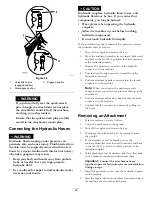
Stability Data
The following tables list the maximum slope recommended for the traction unit in the positions listed in the tables. Slopes over
the listed degree may cause the traction unit to become unstable. The data in the tables assume that the loader arms are fully
lowered; raised arms may affect the stability.
In each attachment manual is a set of 3 stability ratings, 1 for each hill position. To determine the maximum slope you can
traverse with the attachment installed, find the degree of slope that corresponds to the stability ratings of the attachment.
Example: If the attachment installed on a TX Model 22327 traction unit has a front uphill rating of B, a Rear Uphill rating of
D, and a Side Uphill rating of C, then you could drive forward up a 19° slope, rearward up a 11° slope, or sideways on a 11°
slope, as listed in the following table.
Models 22327, 22327G, and 22327HD
Maximum Recommended Slope when
Operating with:
Front Uphill
Rear Uphill
Side Uphill
Configuration
Traction unit without attachment
15°
19°
16°
Traction unit with an attachment rated with 1 of the following stability ratings for
each slope position:*
A
25°
25°
20°
B
19°
20°
15°
C
16°
17°
11°
D
14°
11°
8°
E
5°
5°
5°
Model 22328 and 22328HD
Maximum Recommended Slope when
Operating with:
Front Uphill
Rear Uphill
Side Uphill
Configuration
Traction unit without attachment
16°
19°
19°
Traction unit with an attachment rated with 1 of the following stability ratings for
each slope position:*
A
25°
25°
23°
B
21°
19°
18°
C
18°
15°
14°
D
15°
10°
10°
E
5°
5°
5°
7
Summary of Contents for 22327
Page 54: ...Schematics g205307 Electrical Schematic Rev B 54...
Page 55: ...g206362 Hydraulic Schematic Rev B 55...
Page 56: ...Notes...
Page 57: ...Notes...
Page 58: ...Notes...























